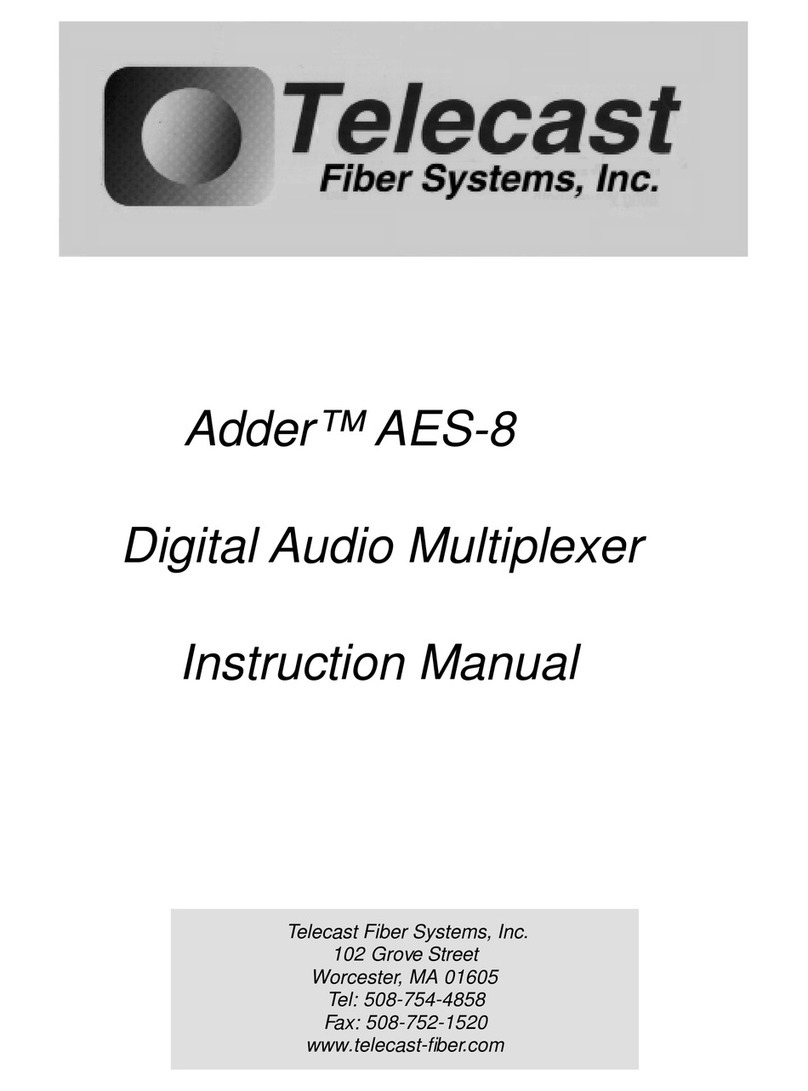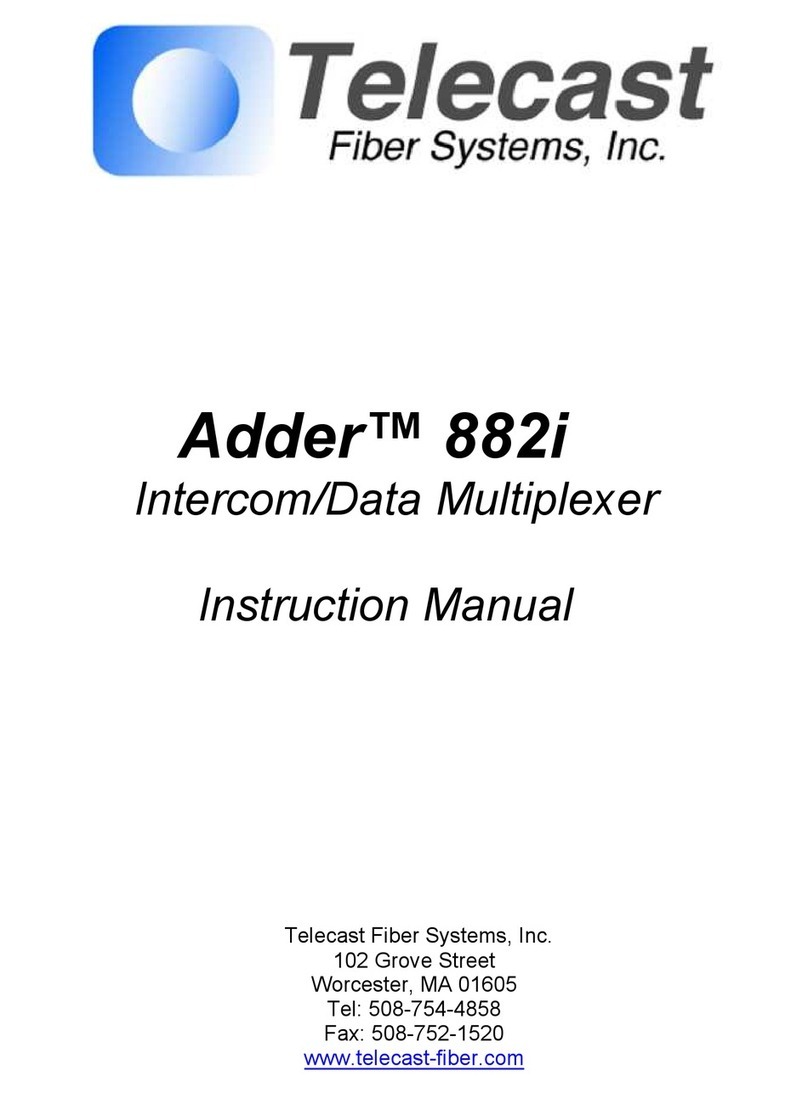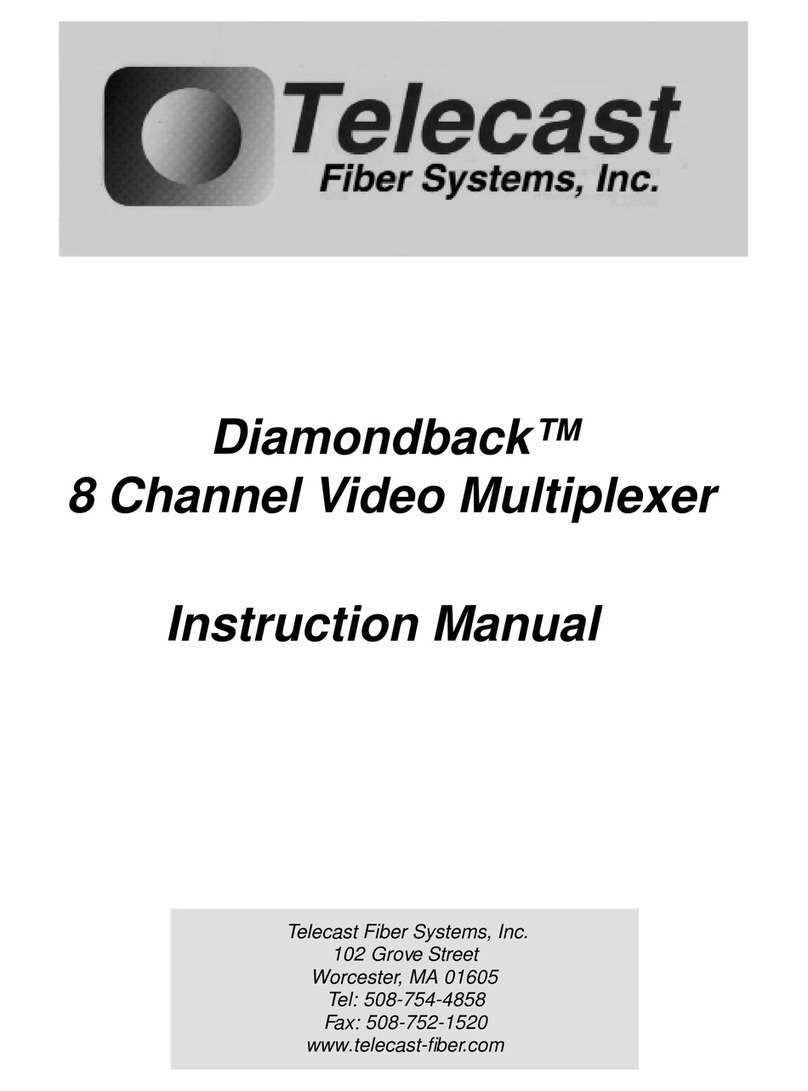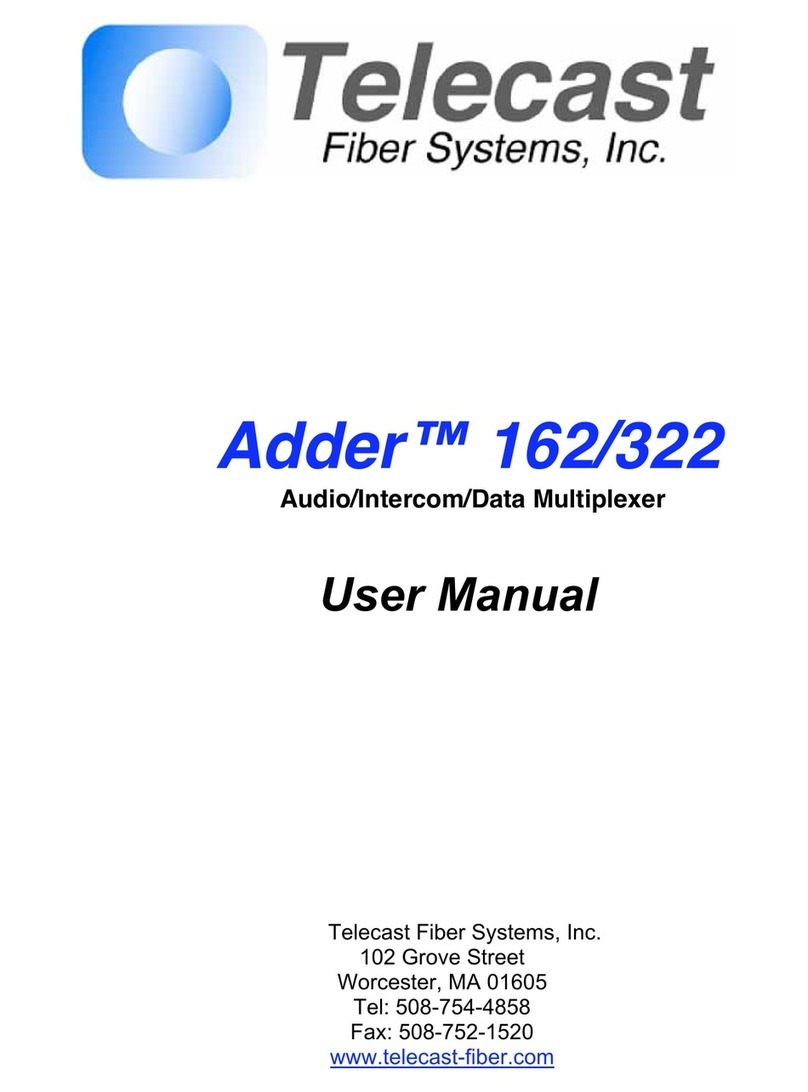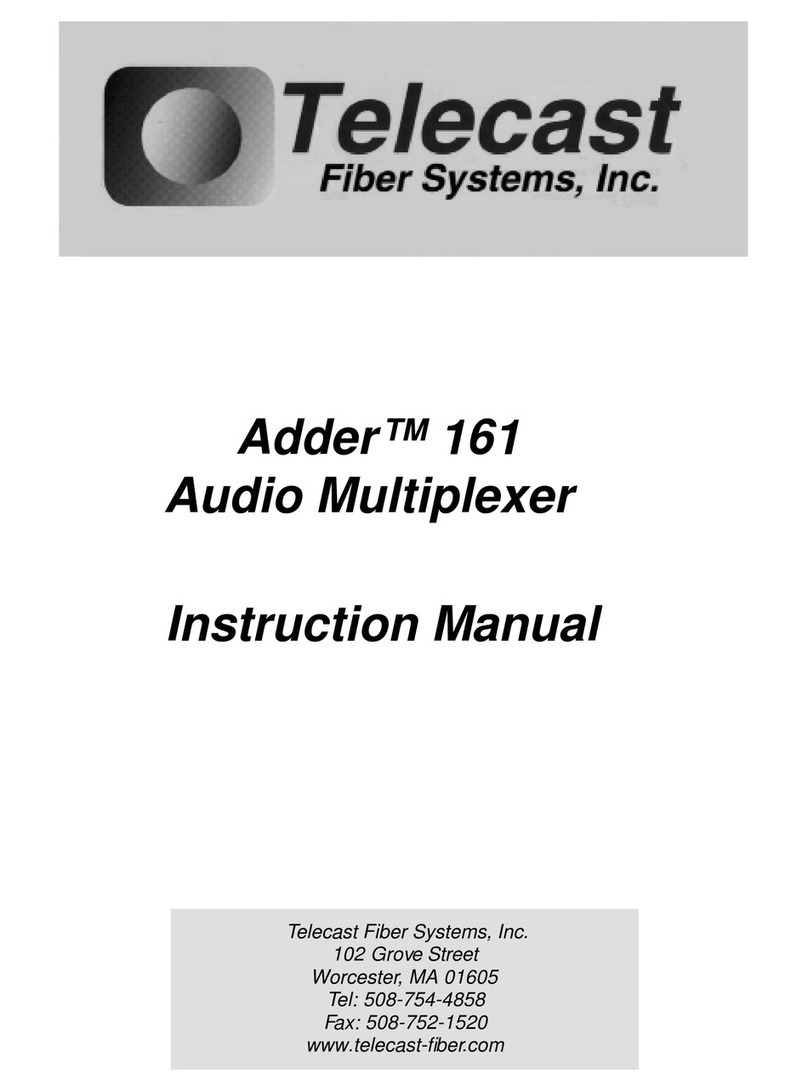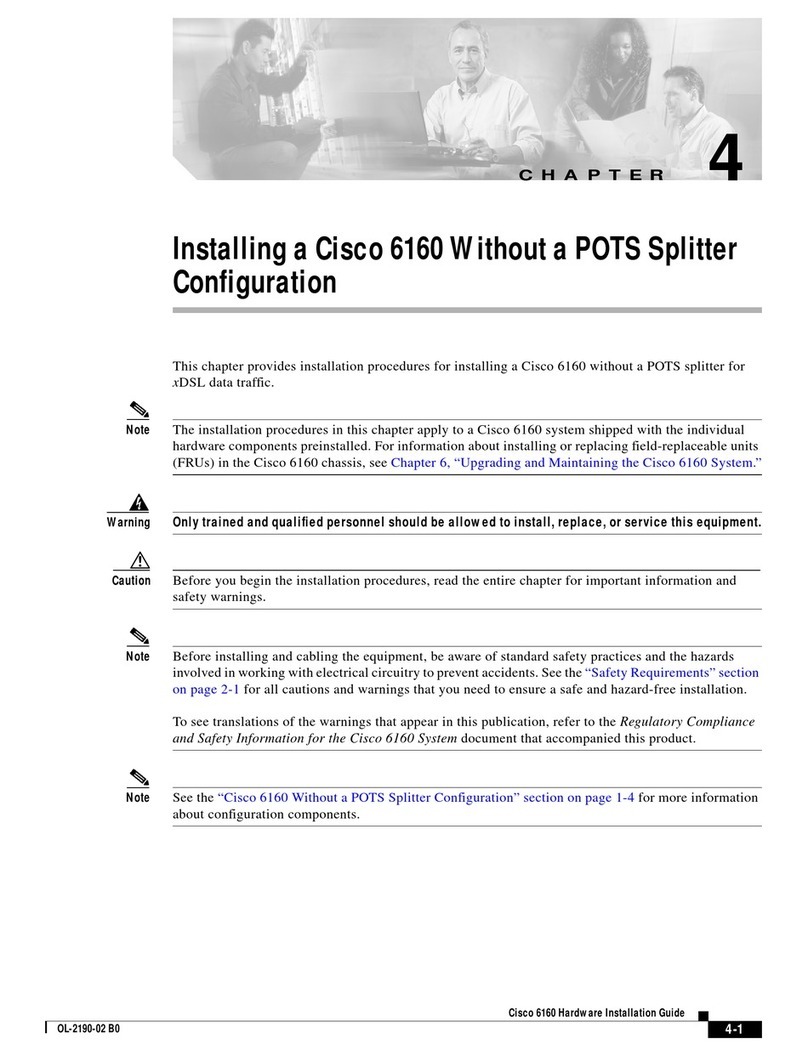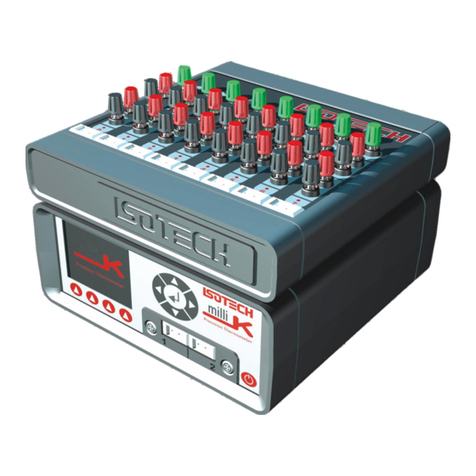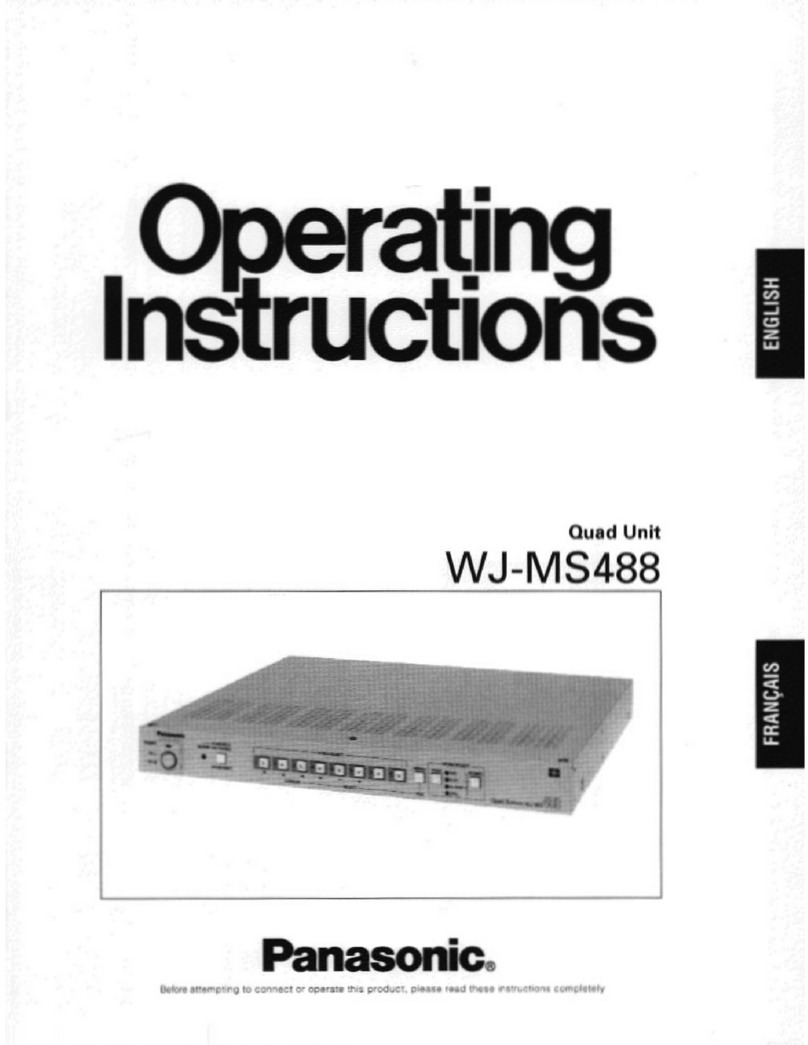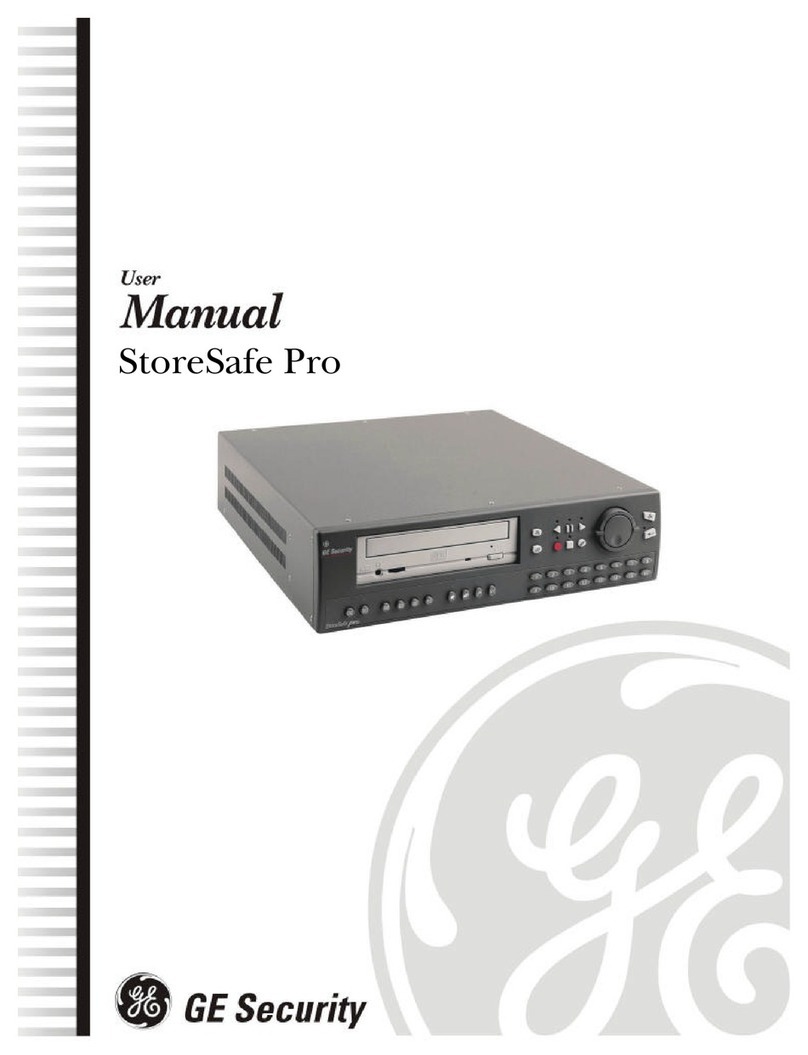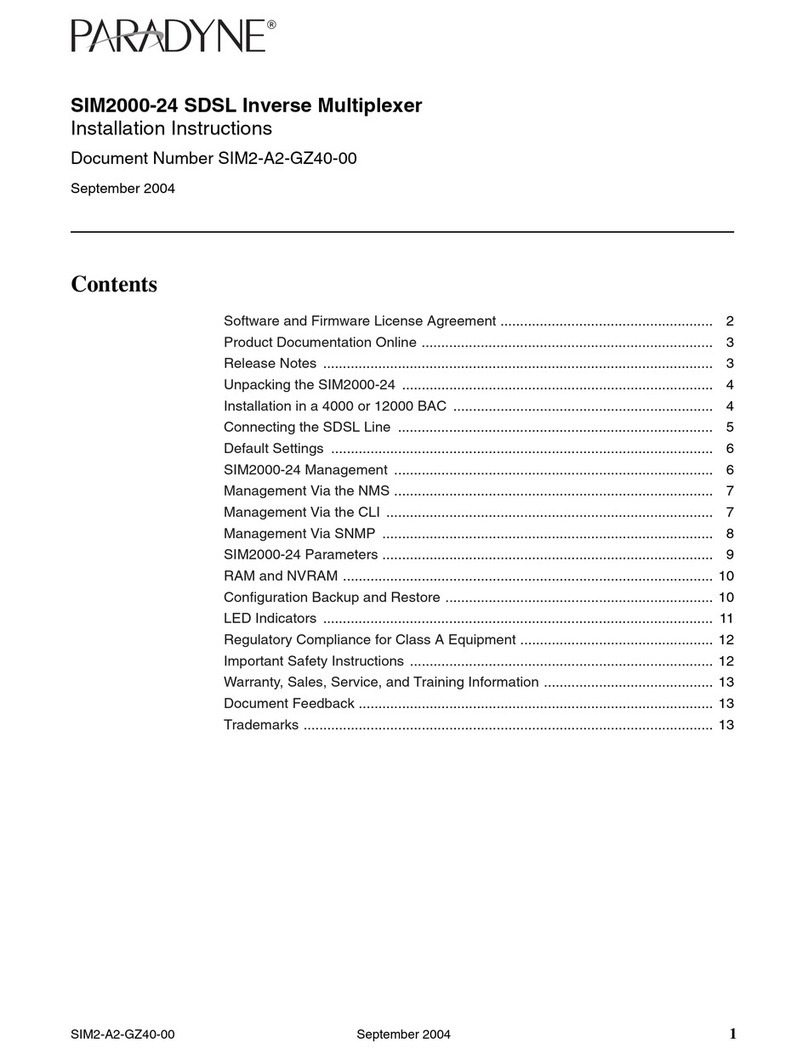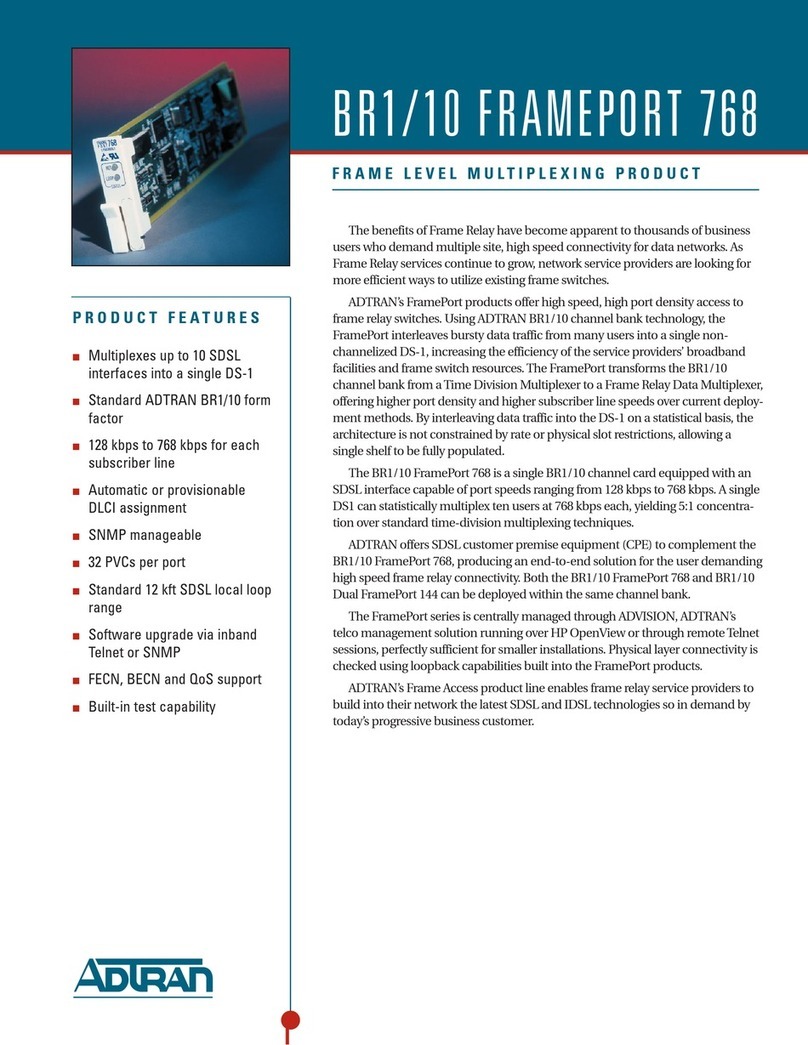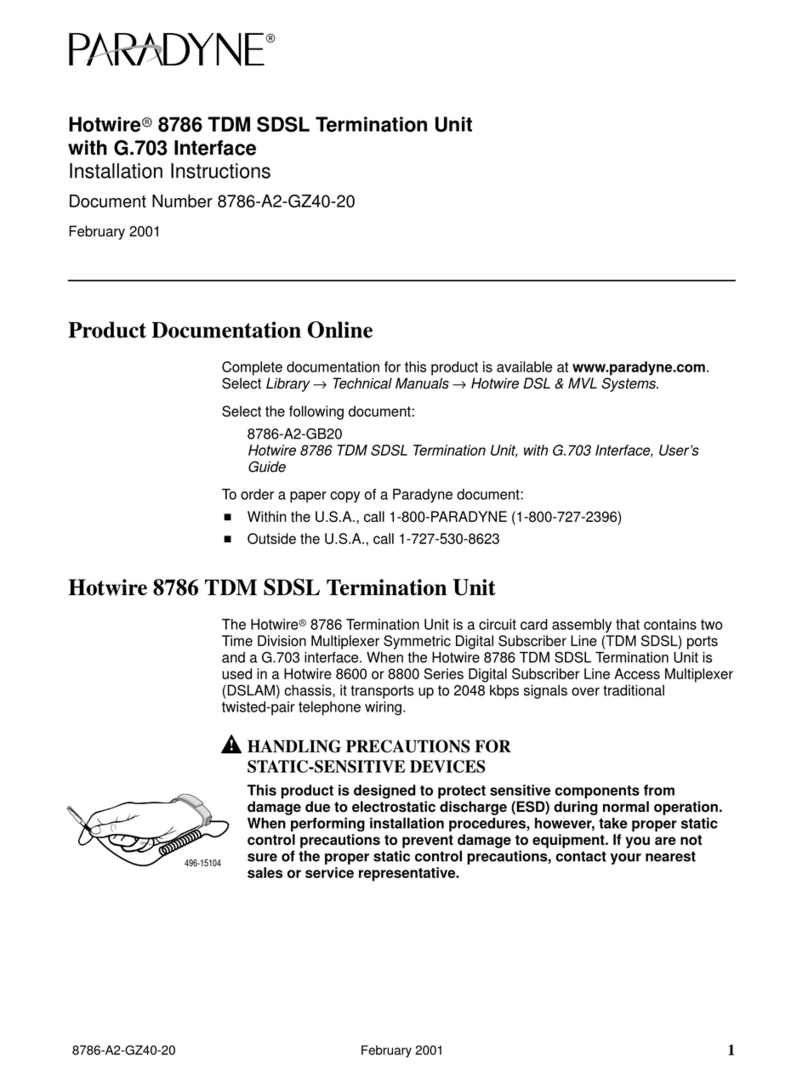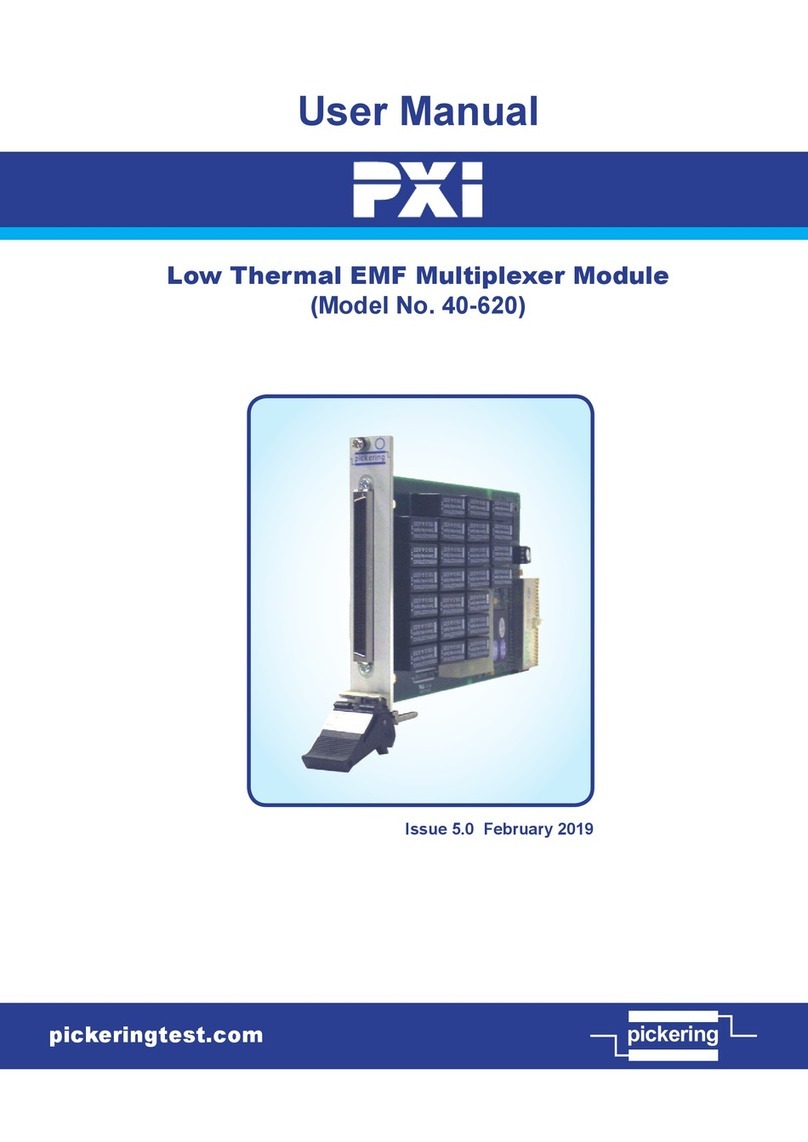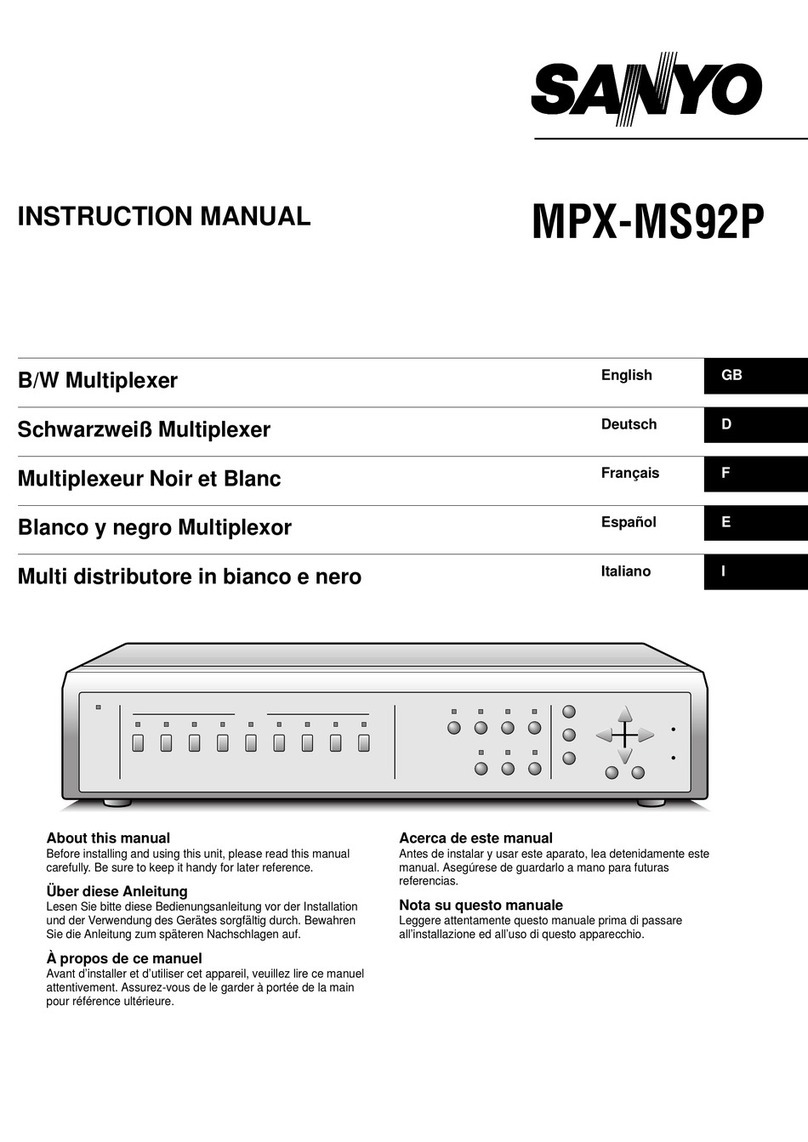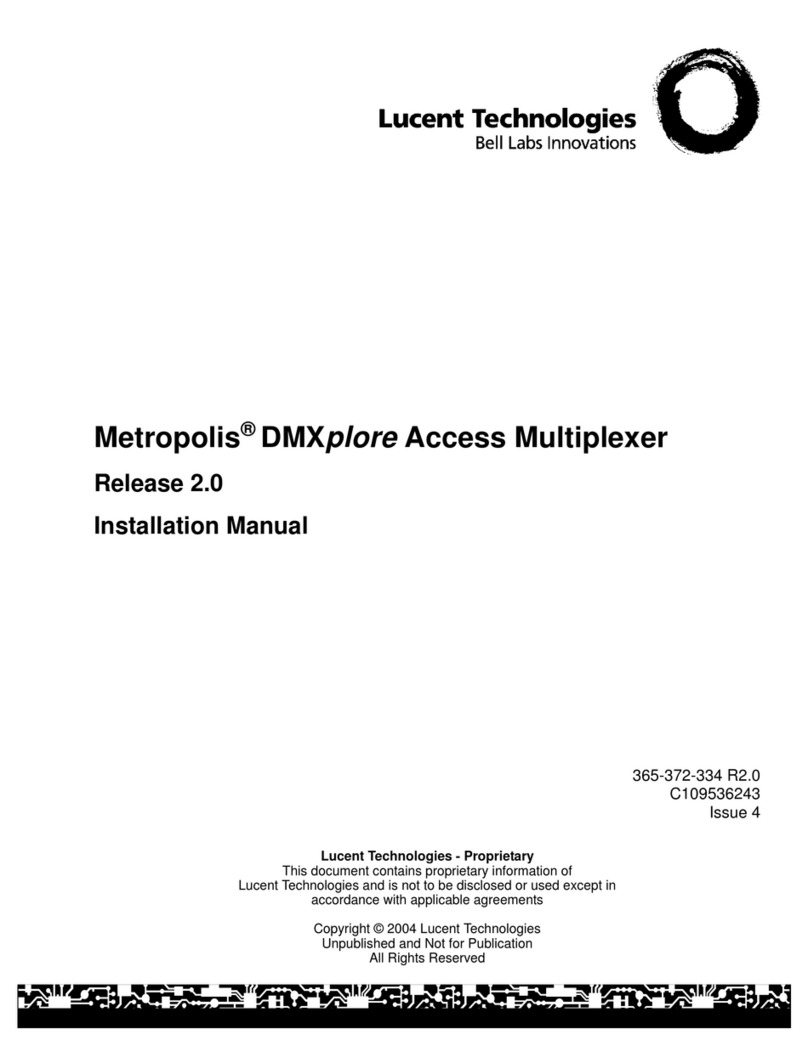Telecast Adder 882 User manual

Adder
ä
882 System
Instruction Manual
Telecast Fiber Systems, Inc.
102 Grove Street
Worcester, MA 01605
Tel: 508-754-4858
Fax: 508-752-1520
www.telecast-Þber.com

Adder 882
ii 1 April 1999

Telecast
Table of Contents iii
Table of Contents
Introduction .................................................................................................................................1
Unpacking ....................................................................................................................................2
Installation ...................................................................................................................................3
Rack Mounted Installation ...........................................................................................................3
Fiber Optic Installation ................................................................................................................3
Audio Setup .................................................................................................................................4
Procedure .....................................................................................................................................4
Optical Connections ....................................................................................................................6
Electrical Connections .................................................................................................................6
Input Power Fuse .........................................................................................................................8
Operating Details .........................................................................................................................9
Battery Charging ..........................................................................................................................9
Powering Up ................................................................................................................................9
Theory of Operation ..................................................................................................................10
Digital I/O ..................................................................................................................................12
Optical .......................................................................................................................................15
Preventive Maintenance ............................................................................................................16
Accessory List ...........................................................................................................................16
Troubleshooting .........................................................................................................................16
Specifications .............................................................................................................................18
Warranty ....................................................................................................................................20

Adder 882
iv 1 April 1999

Telecast
List of Figures v
List of Figures
Figure 1. Rear Panel of the Adder 882.........................................................................................1
Figure 2. Block Diagram of a One Fiber System.........................................................................2
Figure 3. Possible Optical Configurations ...................................................................................2
Figure 4. Installing the Rack Mount Adapters .............................................................................3
Figure 5. Audio Setup Controls....................................................................................................5
Figure 6. Main Circuit Board .......................................................................................................5
Figure 7. ST Optical Connectors on the Rear Panel.....................................................................6
Figure 8. XLR Connectors on the Rear Panel..............................................................................7
Figure 9. RS-422 D Connectors on the Rear Panel......................................................................8
Figure 10. Power Connector and Fuse Locations...........................................................................8
Figure 11. Front Panel....................................................................................................................9
Figure 12. Electronics Block Diagram.........................................................................................10
Figure 13. Audio Input Buffer Circuit..........................................................................................11
Figure 14. Audio Output Buffer Circuit.......................................................................................11
Figure 15. Digital I/O Connectors 1, 3, 5 and 7 ...........................................................................13
Figure 16. Digital I/O Connectors 2, 4, 6 and 8 ...........................................................................14
Figure 17. Battery Charger Block Diagram .................................................................................15
List of Tables
Table 1. Maximum Fiber Lengths............................................................................................... 3
Table 2. Audio Inputs.................................................................................................................. 4
Table 3. Input and Output Cable Connections............................................................................ 6
Table 4. Digital Cable Connections ............................................................................................ 7
Table 5. Power Connections ....................................................................................................... 8
Table 6. Adder 882 Main Circuits ............................................................................................ 17
Table 7. Troubleshooting Chart ................................................................................................ 18

Adder 882
vi 1 April199

Telecast
Introduction 1
Introduction
The Telecast Adder
TM
882 System consists of two Adder 882 Þber optic
multiplexer/demultiplexers that simultaneously send and receive up to eight audio signals, eight
digital datas, and four remote relay closures in each direction. These signals are transmitted on
optical Þbers. Audio inputs are set up by internal DIP switches that set ampliÞer gain to accept
either mic or
line levels. Audio outputs are always at line levels. Digital inputs and outputs are
RS-422 and RS-232 compatible signals. Four of the digital connectors also provide contact
closure input and output. The other four connectors alternatively provide SONY CCU compatible
interfaces. All connections are made via the rear panel. See Figure 1.
Figure 1. Rear Panel of the Adder 882
Within an Adder 882 unit, the audio signals are Þrst digitized and then multiplexed with the
digital data and control signals. The combined electrical signal is converted to an optical signal,
launched into the optical Þber and sent to a second Adder 882. This second unit receives the
optical signal, converts it into an electrical data stream, demultiplexes the signals and restores the
audio signals to analog levels.
An internal Ni-Cad battery provides backup in the event of line power loss.
The Adder 882 is available with several optical options and conÞgurations.
¥ Standard connection with bidirectional signals carried on two optical Þbers at either 850, 1300,
or 1550 nm.
¥ One Þber connection with optically combined bidirectional signals at 850/1300 nm or
1300/1550 nm as shown in Figure 2.
In a standard two Þber system,
identical
Adder 882 units are used at each location. The units both
transmit at 850 nm on ST connector
A
and receive the 850 nm signal on ST connector
B
. They are
connected by the two Þbers so that the optical output of each box is connected to the optical input
of the other. In both one and two Þber systems, the input of channel 1 on one unit becomes the
output of channel 1 on the other unit, and vice versa.
In a one Þber system, the two Adder 882 units are
not identical
and are conÞgured before
shipment. They must be used as a pair. The units are connected by a single Þber that is wavelength
division multiplexed (WDM). One unit transmits from the
A
ST connector at a wavelength of
1300 nm and also receives at 850 nm on the same connector. The other unit transmits from the
A
ST connector at 850 nm and similarly receives at 1300 nm on the same connector.
Figure 3 illustrates available optical conÞgurations of the ADDER 882.
2AMP, SLO BLO
AUDIO IN 1
AUDIO OUT 1
DC INPUT
12-24VDC
OPTICAL I/O
A(Tx)
B(Rx)
DATA I/O
AUDIO IN 2
AUDIO OUT 2
AUDIO IN 3
AUDIO OUT 3
AUDIO IN 4
AUDIO OUT 4
AUDIO IN 5
AUDIO OUT 5
AUDIO IN 6
AUDIO OUT 6
AUDIO IN 7
AUDIO OUT 7
AUDIO IN 8
AUDIO OUT 8
1
3
5
7
2
4
6
8

Adder 882
2 1 April 1999
Figure 2. Block Diagram of a One Fiber System
Figure 3. Possible Optical ConÞgurations
Unpacking
The Adder 882 System consists of:
¥ Two Adder 882 multiplexer/demultiplexer units
¥ Two external power supplies (AC/DC adapters)
¥ Rack mount hardware kits
¥ Plastic or metal covers for optical connectors
850 nm
1300 nm
Unit A Unit B
1300 nm
850 nm
LED
WDM
DET
ST type
Single Optical
850 nm
1300 nm
LED
WDM
DET
8Audio in
8Digital in (RS-422)
8Audio out
8Digital out (RS-422)
Audio in 8
Digital in (RS-422) 8
Audio out 8
Digital out (RS-422) 8
connector
Fiber
850 nm
850 nm
1300 nm
1300 nm
1550 nm
1550 nm
850 nm
1300 nm
Unit AUnit B
Unit A Unit B
Unit A Unit B
Unit A Unit B
Unit AUnit B
1300 nm
1550 nm
TX 850 nm
RX 850 nm
TX 1300 nm
RX 1300 nm
TX 1550 nm
RX 1550 nm
TX 850 nm
RX 1300 nm
TX 1300 nm
RX 1550 nm
RX 850 nm
TX 850 nm
RX 1300 nm
TX 1550 nm
RX 850 nm
TX 1300 nm
RX 1550 nm
TX 1550 nm
RX 1300 nm
TX 1300 nm

Telecast
Installation 3
Installation
Inspect the units for mechanical damage. Inspect all electrical connectors for bent or damaged
pins and latches. Report any damage to the carrier and to Telecast Fiber Systems, Inc.
Leave the protective plastic caps on the optical connectors until it is time to attach the Þber(s) to
the units. Store the caps in the plastic bag packed with this manual. Place the caps back on the
connectors whenever the Þbers are left disconnected.
Rack Mounted Installation
Units are shipped ready for bench use. To rack mount the units, mounting adapters must be
attached. Each adapter is held in place by two #10 ßat head screws (see Figure 4).
Figure 4. Installing the Rack Mount Adapters
Place the units in their intended locations before attaching any cables or wires. This will prevent
accidental damage to the cables or their connectors.
Fiber Optic Installation
The installer is responsible for providing the Þber optic cable runs which are available from
Telecast Fiber Systems, Inc. Refer to the Accessory List on page 16 of this manual for the cable
and other items required for system installation. Be sure that the Þber core diameters are
compatible with the intended installation distances as shown in Table 1.
The system units have been conÞgured at the factory for the Þber type with which they are going
to be used.
Mark or tag the optical Þbers when they are pulled, carefully avoiding the Þber tip, so that their
identity is known at both ends. If there is confusion about the identity of the two Þbers, illuminate
the end of one Þber with a ßashlight and look for the light at the other end.
Table 1. Maximum Fiber Lengths
Fiber core diameter Maximum Þber length
50 microns 5 km (3 mi)
62.5 microns 3 km (2 mi)
8 microns (single mode) 10 km (6 mi)
ADDER 882
ä
AUDIO/DATA MUX/DEMUX
TELECAST
FIBER SYSTEMS, Inc.
Made in the USA

Adder 882
4 1 April 1999
WARNING Do NOT use the Adder 882 optical output for this purpose. Never look
directly into the end of the optical Þber while either end of the system is
operating. Eye damage is possible.
Inspect the Þber ends and clean them with clean, dry compressed air or with Kim-Wipes that have
been wet with isopropyl alcohol. Fingerprints or other dirt on the optical connector end surfaces
will reduce the received optical signal level.
Audio Setup
The setup switches for line
or microphone inputs levels are inside the Adder 882. Setup steps are
not
required if all inputs are at the factory default 600
W,
0 dB gain, line level. Setup
is
required if
microphone inputs are used, if 5 k
W
input impedance is required, or if the optional 10 dB
boost/cut is desired on line inputs.
Procedure
1. Determine which inputs will be connected to microphones and for which line I/O the 10 dB
boost/cut is to be used.
2. Copy Table 2 and Þll in the required I/O characteristics. Recopy the original table for use with
other hookups.
3.
With the power switch off
, take off the top cover of the unit by removing the #4 ßat head screw
at each corner.
In Figure 5,
A
refers to the odd numbered channel and
B
refers to the even numbered channel of
the pair.
4. With the rear of the unit facing you (connector end), move the slide switches shown in
Figures 5 and 6 to match the settings in Table 2. The controls are arranged in pairs.
Table 2. Audio Inputs
Channel Number
UNIT A SWITCH SETTING 12345678
MIC
IN
(0 or +40 db gain)
LINE
IN
(0 or +10 db gain)
INPUT IMPEDANCE
(600
W
or 5 k
W
)
LINE
OUT
(0 or
-
10 db gain)
UNIT B SWITCH SETTING 12345678
MIC
IN
(0 or +40 db gain)
LINE
IN
(0 or +10 db gain)
INPUT IMPEDANCE
(600
W
or 5 k
W
)
LINE
OUT
(0 or
-
10 db gain)

Telecast
Installation 5
Figure 5. Audio Setup Controls
5. Replace the top cover and gently reinstall the screws.
Figure 6. Main Circuit Board
Zin
Gain
Lo
Lo
40
10
40
10
Ä
Gain
A
B
B
A
ABAB
-10 -10
Fine
Level
Switches are shown in the factory default position.
Input Output
Inputs @ 600 W, unity gain. Outputs @ unity gain.
Ä

Adder 882
6 1 April 1999
Optical Connections
Refer to Figure 7 before beginning the optical connections.
Figure 7. ST Optical Connectors on the Rear Panel
WARNING Never look directly into the end of the optical Þber while either end of the
system is operating. Eye damage is possible.
The Adder 882 is compatible with industry standard ST type connectors. It may be used with
installed backbone cables or with dedicated cables.
Assembled cables and connectors are available from Telecast Fiber Systems, Inc. For custom
cable fabrication, use type ST connectors such as Telecast part number CONN-ST-QC.
Always follow the connector manufacturerÕs directions when fastening a connector to the cable. A
Quick-crimp kit, part number CKIT-ST-QC, is available from Telecast.
On a two Þber system, connect the cables so that transmitter ST
A
at one end connects to receiver
ST Bat the other end.
On a one Þber system, connect the Þber optic cable to the ST A at each end.
Electrical Connections
Audio
Input and output audio connections use 3-pin XLR connectors with industry standard wire
locations. Table 3 and Figure 8 show these connections.
Table 3. Input and Output Cable Connections
Pin Signal
1 Ground
2 Balanced I/O (-)
3 Balanced I/O (+)
2AMP, SLO BLO
DC INPUT
12-24VDC
OPTICAL I/O
A (TX)
B (RX)
DATA I/O
AUDIO IN 1
AUDIO OUT 1
AUDIO IN 2
AUDIO OUT 2
AUDIO IN 3
AUDIO OUT 3
AUDIO IN 4
AUDIO OUT 4
AUDIO IN 5
AUDIO OUT 5
AUDIO IN 6
AUDIO OUT 6
AUDIO IN 7
AUDIO OUT 7
AUDIO IN 8
AUDIO OUT 8
1
3
5
7
2
4
6
8

Telecast
Installation 7
Figure 8. XLR Connectors on the Rear Panel
The audio input connector is Switchcraft E3FST-AU. The audio output connector is Switchcraft
E3MST-AU.
Digital
Digital signal connections are made via the 9-pin D connectors described in Table 4 and
illustrated in Figure 9. A 110 Wterminating resistor placed across the balanced inputs may be
needed if cable lengths using 110 Wtwisted pairs are in excess of 6 feet. The serial
communications protocol can be RS-232 at one end and RS-422 at the other, if desired.
Contact closure input is activated by connecting it to ground. Contact closure output is an isolated
dry contact.
If SONY CCU interface operation is selected, RS-422 and RS-232 functions are not available at
that connector.
Table 4. Digital Cable Connections
Pin
Number
Connectors
1, 3, 5, 7 (Left)
Connectors 2,4,6,8 (Right)
Serial Com. CCU
1 RS-422 in (-) RS-422 in (-) No connection
2 Contact out No connection CCU I/O
Jumper to pin 6
3 Ground Ground Ground
4 RS-232 out RS-232 out No connection
5 RS-422 out (-) RS-422 out (-) Jumper to pin 8
6RS-422 in (+)
RS-232 in
RS-422 in (+)
RS-232 in
CCU I/O
Jumper to pin 2
7 Contact out No connection No connection
8 Contact in No connection Jumper to pin 5
9 RS-422 out (+) RS-422 out (+) No connection
2AMP, SLO BLO
DC INPUT
12-24VDC
OPTICAL I/O
A (Tx)
B (Rx)
DATA I/O
2
3
1
Male XLR
1
3
2
Female XLR
AUDIO IN 1
AUDIO OUT 1
AUDIO IN 2
AUDIO OUT 2
AUDIO IN 3
AUDIO OUT 3
AUDIO IN 4
AUDIO OUT 4
AUDIO IN 5
AUDIO OUT 5
AUDIO IN 6
AUDIO OUT 6
AUDIO IN 7
AUDIO OUT 7
AUDIO IN 8
AUDIO OUT 8
1
3
5
7
2
4
6
8

Adder 882
8 1 April 1999
Figure 9. RS-422 D Connectors on the Rear Panel
The digital I/O connector is AMP 747905-2.
Power Connector
When using the standard Telecast power supply, connect the 4-pin XLR connector to the
Adder 882 and plug the supply into a 120 VAC line. See Figure 10.
Figure 10. Power Connector and Fuse Locations
Any power supply used with the Adder 882 must supply 1.5 amperes continuous current. Use the
wiring connections shown in Table 5. The power connector is Switchcraft D4M.
Input Power Fuse
The 2 ampere time delay power fuse is accessible from the rear panel (see Figure 10). Be sure to
use the same fuse type if replacement is required.
Table 5. Power Connections
Pin Signal
1 Ground
2 Not used
3 Not used
4 +12 to 24 VDC (Abs. Max. 30 VDC)
2AMP, SLO BLO
DC INPUT
12-24VDC
OPTICAL I/O
A (TX)
B (RX)
DATA I/O
15
69
Female 9-Pin D
AUDIO IN 1
AUDIO OUT 1
AUDIO IN 2
AUDIO OUT 2
AUDIO IN 3
AUDIO OUT 3
AUDIO IN 4
AUDIO OUT 4
AUDIO IN 5
AUDIO OUT 5
AUDIO IN 6
AUDIO OUT 6
AUDIO IN 7
AUDIO OUT 7
AUDIO IN 8
AUDIO OUT 8
1
3
5
7
2
4
6
8
2AMP, SLO BLO
DC INPUT
12-24VDC
OPTICAL I/O
A (Tx)
B (Rx)
DATA I/O
Male 4-Pin XLR
1
23
4
AUDIO IN 1
AUDIO OUT 1
AUDIO IN 2
AUDIO OUT 2
AUDIO IN 3
AUDIO OUT 3
AUDIO IN 4
AUDIO OUT 4
AUDIO IN 5
AUDIO OUT 5
AUDIO IN 6
AUDIO OUT 6
AUDIO IN 7
AUDIO OUT 7
AUDIO IN 8
AUDIO OUT 8
Input
Power
Fuse
1
3
5
7
2
4
6
8

Telecast
Operating Details 9
Operating Details
Battery Charging
Charge the internal UPS batteries at a minimum 13.8 VDC for 16 hours (40 mA trickle charge) by
attaching each unit to its external power supply. This will permit battery operation for up to
20 minutes during line power losses.
Indicators
The three LEDs on the front panel are shown in Figure 11.
Figure 11. Front Panel
¥EXTERNAL POWER .When this green LED is illuminated, an external supply of between 12 and
24 VDC is connected.
¥INTERNAL RESERVE .This LED is illuminated green when the power is on and the internal
battery is adequately charged. This LED lights after one half hour of charge. There may be a
few minutes of reserve after the indicators extinguish. This LED is illuminated red when the
internal battery is discharging.
¥LINK STATUS .This red LED is on when the Þber optic link is not properly attached, or the
system units are not communicating properly. This indicator is meaningful only if one of the
other two LEDs is on.
¥AUDIBLE ALARM .An audible alarm has been incorporated into the Adder 882 in addition to the
LED indicators on the front panel. This alarm alerts the user that the internal batteries are
discharging. A defeat switch for the audible alarm is located inside the unit on the main circuit
board.
Powering Up
Note: A locking switch is provided to prevent inadvertent power turn off. Never try to move the
front panel switch without Þrst pulling on the switch lever to disengage its lock.
With power OFF at both units, check all electrical and optical connections as described in
Installation on page 3. Firmly seat and latch all connectors. To operate the power switch:
1. Pull the lever away from the panel.
2. Move it up for power ON, or down for power OFF.
The power switches at both units must be on for the system to achieve normal function.
3. Switch on the power to both Adder 882 units.
Verify that the green EXTERNAL POWER LEDs are illuminated, and that the red LINK STATUS
LEDs do not light. If you do not get this result, refer to the Troubleshooting Chart on page 16.
POWER
ADDER 882
ä
AUDIO/DATA MUX/DEMUX
Fiber Systems, Inc.
Telecast
INTERNAL
RESERVE
LINK STATUS
EXTERNAL
POWER
ON
OFF

Adder 882
10 1 April 1999
Theory of Operation
The Adder 882 circuit block diagram is shown in Figure 12. The unit has two basic functions:
multiplexing signals onto an optical Þber, and demultiplexing signals from an optical Þber. The
Adder 882 accepts up to eight audio inputs, eight digital inputs and four remote relay closures and
time division multiplexes them onto a single optical Þber.
Figure 12. Electronics Block Diagram
All signals on the optical Þber are digital and, therefore, relatively insensitive to transmission
level variations. As a demultiplexer, the unit separates the multiplexed signals it receives from the
optical Þber and converts the audio information back into analog signals.
There is a one-to-one correspondence between inputs and outputs at opposite ends of the system.
Audio inputs and outputs are on separate sets of eight XLR connectors located on the rear panel.
Refer to Figure 1 on page 1.
For details on setting up the audio circuits refer to Audio Setup on page 4. Inputs can be set to
have a balanced 600 Wor 5 kWbuffer circuit that is shown in Figure 13.
The audio input buffer circuit shown in Figure 13 can accept two signal levels:
¥LINE input, factory default. Set the input buffer to unity gain. The gain of the input can
optionally be set to +10 dB, and the output to -10 dB. This provides a lower noise ßoor, but
decreases the clipping level from +18 dBm to +8 dBm.
¥MICROPHONE input. Set the input buffer to a gain of 40 dB.
MULTIPLEXER
TYP 1 of 8 A/D
+
-
GAIN
TYP 1 of 8 +
-
AUDIO
INPUT/(LINE MIC)
DIGITAL INPUT/ (RS 422)
TX
FIBER OPTIC CABLE
l
TIMING LINK STATUS
DEMULTIPLEXER
D/A +
-
AUDIO INPUT
(LINE)
DIGITAL INPUT
TYP 1 of 8
D/A +
-TYP 1 of 8
lTX
FIBER OPTIC CABLE

Telecast
Theory of Operation 11
Figure 13. Audio Input Buffer Circuit
The audio output circuit is shown in Figure 14. The output impedance is 30 W, balanced.
Figure 14. Audio Output Buffer Circuit
2
12
Ferrite Bead
+8
3
1
8
4
MC33078
10pF
.1
.1
10pF
4.99k
-8
5
2.49k
6
7
MC33078
680
3
1
2
1
0
2
Ferrite Bead
2.49k
Audio In
123
654
Mode
4.99k
4.64k
100
1 2
Ferrite Bead
15 W
2.0k
10
9 8
MC33179
2.0k
3
2
1
0
Audio Out
2.0k
4.99k
.015 Film
2.0k
5
67
MC33179 Ferrite Bead
1 2
15 W
mF Film

Adder 882
12 1 April 1999
Digital I/O
The digital input buffer circuits shown in Figures 15 and 16 accept and drive industry standard
RS-422, RS-423, and RS-232 signal levels. These circuits may be used to convert from one signal
format to another.
The digital output circuit shown in Figure 15 can be conÞgured by the user to provide SONY
CCU compatible I/O; contact closure circuits are not provided on connectors 2, 4, 6, and 8. Refer
to Table 4, ÒDigital Cable Connections,Ó on page 7 for instructions on selecting the CCU
capability. When this option is selected, the RS-422 and RS-232 serial communications for that
connector are not available.
The circuits in Figure 15 also provide contact closure inputs and outputs. The contact closure
inputs are made by connecting pin 8 to ground (pin 3). This may be accomplished with a TTL
output referenced to pin 3 as ground. The output contact closure is an SPST-NO relay and is not
ground referenced.

Telecast
Theory of Operation 13
Figure 15. Digital I/O Connectors 1, 3, 5 and 7

Adder 882
14 1 April 1999
Figure 16. Digital I/O Connectors 2, 4, 6 and 8
Table of contents
Other Telecast Multiplexer manuals

